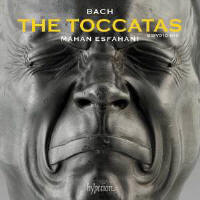Reviewer: James
V. Maiello
Bach wrote the Toccatas, BWV
910–916, in his early 20s, most likely while he was working at the ducal
court at Weimar. They reveal his engagement with the music of North German
composers like Buxtehude and Bruhns, as well as the young Bach’s identity as
a keyboardist, composing at the harpsichord or organ. At the end of his time
at Weimar, a more conceptual, abstract process would emerge as he
encountered Vivaldi’s music and matured as a composer. In the early 1700s,
though, Bach had a well-deserved reputation as a keyboard virtuoso, and one
of the attendant professional skills of any such musician was improvisation,
often in the form of toccatas and fantasias.
It is here that Esfahani falls short in his approach to these
works. To be clear, this is not a question of technique. He is a fine
harpsichordist, and he plays with exceptional control and precision. The
nature of a toccata, though, is one of extemporaneity, moving between
motives and thematic ideas with nonchalance and a certain impulsivity.
Esfahani takes a measured approach that makes Bach’s flourishes and
machinations sound stiff and contrived, though the playing is clean and
accurate. This might work well as a contrast to more improvisatory sections,
but not as a default approach, which tends to get too heavy and plodding.
This is particularly noticeable in the Toccata in C Minor, BWV 911, for
example: Esfahani’s stricter approach in imitative sections is spot-on, and
were it paired with a more flexible reading of the freer ones, it could be
revelatory. Likewise, the Toccata in G Minor, BWV 915, is too regulated for
me. It is full of opportunities to sound free and loose, but these are
controlled too tightly and do not provide enough contrast with the stricter
sections. Again, this is a difference of opinion about interpretation, not a
comment on Esfahani’s skills as a harpsichordist. Moreover, the instrument
itself sounds great, rich and clear, but with just a little bite; Hyperion’s
recording is clean and well balanced, as usual.
There is also the issue of the liner notes, a pseudo-scholarly ramble during
which Esfahani details his reasons for making his own editions from various
sources and outlines his process for doing so. Clearly, he is dissatisfied
with the performing editions available and seems to have a measure of
disdain for the musicologists who have edited them, though he does not
explain these grievances adequately or convincingly. Esfahani’s declaration
that he used “the old Bach-Gesellschaft printings as a template on
which [he] then notated the variants from each source” is problematic as an
editorial method for a number of reasons. Chief among them is that these
19th-century editions are universally acknowledged to be riddled with
errors, rendering them a wholly inappropriate model for comparison. Even if
all the variants are considered, starting from the BG, even if only for
convenience, this creates an implicit bias toward the BG as authoritative.
He might have been better to use the Neue Bach Ausgabe, which
contains much more reliable material for reference. Moreover, Esfahani’s
argument that “the musicological act is not one of establishing the textual
primacy of the sources but rather one of discovering the musical philosophy
behind the copying of those sources and the relation of that philosophy to
the physical act of playing and, more importantly, the artistic act of
interpreting” is nonsensical. The musicological aims he identifies are not
mutually exclusive, and one informs the other, or at least it should. Were
Esfahani so concerned about ability of musicology to affect interpretation,
he might have made something of Bach’s subtle allusions to dance styles or
emphasized the sectional contrasts so central to the musical aesthetics of
the period. At the very least, the performances should have reflected
improvisatory essence of the toccata as a genre.
In any
case, these are technically competent readings of the toccatas, but they are
too rigid and structured for my taste, and there are too many recent
recordings that take a more nuanced approach to Bach’s music for me to
recommend this recording. By way of example, both Stefano Innocenti
(Stradivarius, 2015) and Blandine Verlet (Decca, 2018) have released fine
recordings of these works recently, and DG reissued in 2013 Trevor Pinnock’s
landmark readings of the toccatas from the 1978 set.
Fermer la fenêtre/Close window
|




